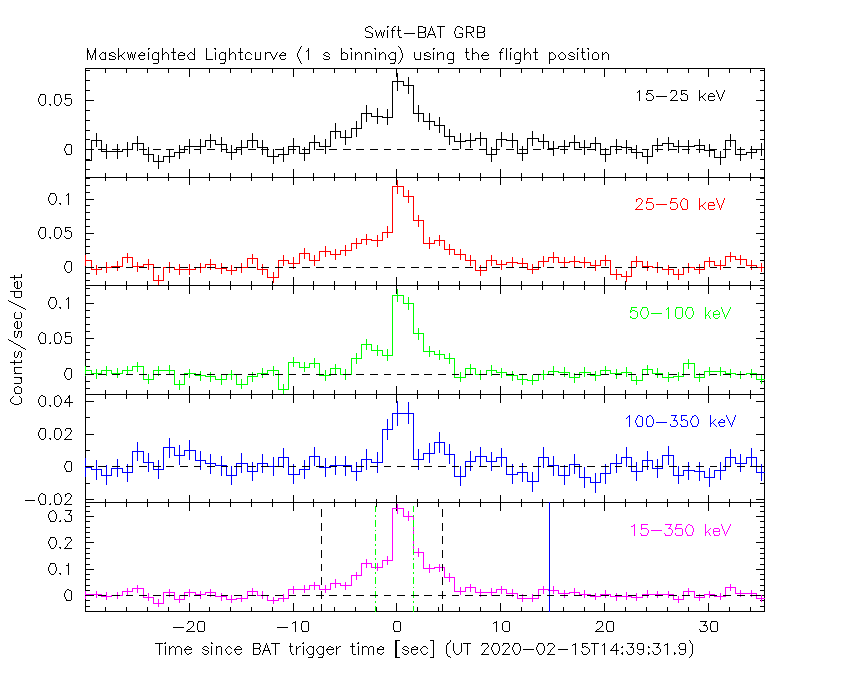
M.G. Bernardini (INAF-OAB), M. Perri (ASDC) and N.P.M. Kuin (UCL-MSSL) for the Swift team
At 14:39:31 UT, the Swift Burst Alert Telescope (BAT) triggered and located GRB 200215A (trigger=956639) (Bernardini et al. GCN Circ. 27079). Swift slewed immediately to the burst. At the time of the trigger, the initial BAT position was 70° from the Sun (4.4 hours East) and 164° from the 54%-illuminated Moon. Table 1 contains the best reported positions from Swift, and the latest XRT position can be viewed at http://www.swift.ac.uk/xrt_positions.
Table 2 is a summary of GCN Circulars about this GRB from observatories other than Swift.
Standard analysis products for this burst are available at https://gcn.gsfc.nasa.gov/swift_gnd_ana.html.
As reported by Barthelmy et al. (GCN Circ. 27098),
the BAT ground-calculated position is RA, Dec = 34.100, 12.775 deg which is RA(J2000) = 0
The mask-weighted light curve (Figure 1) shows a single symmetrical peak from roughly
The time-averaged spectrum from T-9.97 to T+5.37 s is best fit by a simple
The results of the batgrbproduct analysis are available at https://gcn.gsfc.nasa.gov/notices_s/956639/BA/.
Analysis of the initial XRT data was reported by Perri et al. (GCN Circ. 27091). We have analysed 17 ks of XRT data for GRB 200215A, from 72 s to 339.9 ks after the BAT trigger. The data comprise 24 s in Windowed Timing (WT) mode (the first 9 s were taken while Swift was slewing) with the remainder in Photon Counting (PC) mode. The enhanced XRT position for this burst was given by Evans et al. (GCN Circ. 27089).
The light curve (Figure 2) can be modelled with a power-law decay with a decay index of α=1.016 (+0.030, -0.028).
A spectrum formed from the PC mode data can be fitted with an absorbed power-law with a photon spectral index of 1.50 ± 0.17. The best-fitting absorption column is 2.0 (+0.8, -0.7) x 1
A summary of the PC-mode spectrum is thus:
Total column: 2.0 (+0.8, -0.7) x 1
Galactic foreground: 1.2 x 1
Excess significance: 1.9 σ
Photon index: 1.50 ± 0.17
The results of the XRT team automatic analysis are available at http://www.swift.ac.uk/xrt_products/00956639.
The Swift/UVOT began settled observations of the field of GRB 200215A 90 s after the BAT trigger
(Kuin and Bernardini GCN Circ. 27090).
No optical afterglow consistent with the XRT position (Evans et al. GCN Circ. 27089) is detected in the initial UVOT exposures.
Table 3 gives preliminary
magnitudes using the UVOT photometric system
(Breeveld et al. 2011, AIP Conf. Proc., 1358, 373).
No correction has been made for the expected extinction in the Milky Way
corresponding to a reddening of

Figure 1. The BAT
mask-weighted light curve in the four individual and total
energy bands. The units are counts

Figure 2. The XRT light curve.
Any data from a crosshatched region are not included in the fit.
| RA (J2000) | Dec (J2000) | Error | Note | Reference |
|---|---|---|---|---|
| 0 |
+12°46'15.6" | 1.4" | XRT-final | UKSSDC |
| 0 |
+12°46'14.9" | 1.5" | XRT-enhanced | Evans et al. GCN Circ. 27089 |
| 0 |
+12°46'31.7" | 1.0' | BAT-refined | Barthelmy et al. GCN Circ. 27098 |
| Band | Authors | GCN Circ. | Subject | Observatory | Notes |
|---|---|---|---|---|---|
| Optical | Lipunov et al. | 27080 | Swift GRB200215.61: Global MASTER-Net observations report |
MASTER | |
| Optical | Xu et al. | 27081 | Nanshan/NEXT optical upper limit | Xinjiang Astro. Obs. | upper limits |
| Optical | Perley and Cockeram | 27086 | Liverpool Telescope upper limits | Liverpool Telescope | upper limits |
| Optical | de Ugarte Postigo et al. | 27088 | Optical observations form Calar Alto 2.2m |
Calar Alto | detection |
| Optical | Xu et al. | 27099 | UKIRT H-band observations | UKIRT | |
| Optical | Watson et al. | 27105 | RATIR Optical Observations | RATIR | upper limits |
| Optical | Strausbaugh and Cucchiara | 27150 | LCO Optical Upper Limits | LCO | upper limits |
| Gamma-ray | Fermi | 27078 | Fermi GBM Final Real-time Localization | Fermi GBM | |
| Gamma-ray | Poolakkil and Meegan | 27087 | Fermi GBM detection | Fermi GBM | Fluence=1.858±0.175x1 (2 |
| Gamma-ray | Sakamoto et al. | 27113 | CALET Gamma-Ray Burst Monitor detection | CALET | |
| Other | Kann and de Ugarte Postigo | 27083 | Possible host galaxy in PanSTARRS |
| Filter | Exp(s) | Mag | ||
|---|---|---|---|---|
| whit |
90 | 240 | 147 | >20.0 |
| 302 | 552 | 246 | >20.0 | |
| white | 90 | 7290 | 581 | >21.2 |
| v | 634 | 5070 | 294 | >18.5 |
| b | 559 | 7092 | 294 | >19.8 |
| u | 302 | 6885 | 481 | >20.3 |
| w1 | 1087 | 6680 | 216 | >19.2 |
| w2 | 10534 | 11091 | 547 | >19.8 |
Table 3. UVOT observations reported by Kuin and Bernardini (GCN Circ. 27090). The start and stop times of the exposures are given in seconds since the BAT trigger. The preliminary 3-σ upper limits are given. No correction has been made for extinction in the Milky Way.
February 21, 2020